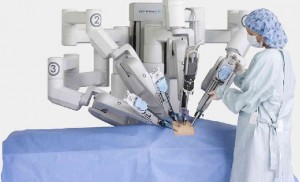Robotic surgery still susceptible to human and technological error
Developed under contract of the United States Army, robotically assisted surgery made its way into civilian hospitals in the United States when it was approved by the Food and Drug Administration (FDA) in 2000.
The first prototype of the da Vinci surgical system was created in the late 1980s at the former Stanford Research Institute (now SRI International). Intended for the battlefield, the system would have allowed military surgeons to operate remotely on wounded soldiers, but its commercial opportunity was evident to a man named Dr. Frederic Moll. In 1995, Dr. Moll co-founded a new company, Intuitive Surgical Inc., with business partners John Freund and Rob Younge and purchased the rights to the surgical system.
In 1997, the first prototype was ready to be tested, and by 2000, the company received clearance from the FDA to use the robotic device in general laparoscopic surgeries, such as gallbladder removal. The FDA subsequently expanded the device’s use to include cardiac, thoracic, urologic, gynecologic, pediatric, and head and neck surgeries.
Since its approval, the da Vinci surgical system has been used in numerous surgeries around the world.
What is the da Vinci surgical system and how does it work?
The da Vinci surgical system uses robotic technology to assist surgeons in complex and delicate operations, which are performed with only a few small incisions in the patient.
The robotic system is intended to perform surgeries more precisely than a human can. The system’s mechanical arms can bend and rotate to a greater extent than the human hand, and the surgeon can view the operation on a magnified, high-def screen.
The surgeon controls the mechanical arms of the system, which perform the surgical operations on the patient, while watching 3D HD screen. Whatever the surgeon does using the master controls, the mechanical arms do inside the patient, but on a smaller, more precise scale.
The da Vinci system is comprised of two main components:
- A console where the surgeon sits during surgery, operates the master controls and watches the screen.
- A patient-side cart with three to four mechanical arms that hold surgical instruments and a camera. The surgical instruments include scalpels, forceps, graspers, dissectors, cautery, scissors, and more.
The problem with robotic surgery
Technology fails
As with all technology, the da Vinci surgical system runs the risk of failure during operations. Numerous reports of one or more of the mechanical arms malfunctioning in the middle of surgery have been submitted to the FDA.
In fact, the FDA has received a number of device failure reports that include breakage of different components, mechanical problems and image or display issues. On its website, Intuitive Surgical warns there is a risk of surgeons having to switch from robotically assisted surgery to more traditional surgical techniques in the middle of the operation due to complications. This can prolong surgery and the time a patient spends under anesthesia which increases the risk of complications, states the company.
Other complications associated with the da Vinci system include:
- Injury to tissues/organs
- Bleeding
- Infection
- Internal scarring
These complications can cause long-lasting dysfunction or pain and may require longer or unexpected hospitalization, according to the company website. These complications may also require reoperation to fix the problem.
Proper training necessary for safe robotic surgeries
Many complications, it seems, arise from accidental nicks and tears to tissue or organs inside the body from the surgical instruments.
Because the da Vinci system is controlled by the surgeon, barring any mechanical or device failure issues, the outcome of the surgery relies almost solely on the capability of the surgeon.
The FDA conceded that robotically assisted surgery is safe and effective only with proper training. The agency, however, “does not regulate the practice of medicine and therefore does not supervise or provide accreditation for physician training, nor does it oversee training and education related to legally marketed medical devices.”
Instead, the agency says “training development and implementation is the responsibility of the manufacturer, physicians and health care facilities.”
According to a survey of 11 surgeons conducted by the FDA, the respondents said they participated in various training sessions sponsored by either Intuitive Surgical or their institutions. Those sessions included a combination of the following training:
- Three to eight hours of online training
- Dry lab training, including modules for system set-up, docking and manipulation of the arms
- Practice time using pigs, dogs or cadavers
- Videos
- Simulated training
- Having manufacturer-paid proctors present for three to five surgeries
All of the surgeons who responded to the survey said they needed to perform multiple surgeries before they felt fully comfortable using the da Vinci system.
Patients suffer from robotic surgery’s shortcomings
The FDA received a growing number of complaints from patients after complications arose from surgery with the da Vinci surgical system. Some of those reports were sent in by family members whose loved ones died as a result of surgical complications.
One man reported that his father died after the surgeon nicked something during a colorectal surgery. His father underwent two subsequent emergency surgeries before succumbing to his injuries.
In another report, a woman said her bladder was damaged during a hysterectomy because a needle fell off the mechanical arm and went missing inside her body.
Another man was reportedly injured after a prostatectomy (prostate removal surgery) when the surgeon tore his intestines and bowels with the da Vinci surgical instruments. The man was reportedly hospitalized for 45 days following the surgery and suffered from fevers, confusion, abdominal distention, sepsis, abscesses and giant fistulas.
Robotic Surgery Lawsuits
Lawsuits against the makers of the da Vinci surgical systems claim that safer alternatives were available and that design defects in the da Vinci system may have been responsible for serious and possibly life-threatening injuries.
If you or a loved one were harmed during a surgery using the da Vinci surgical system, please do not hesitate to act. Call the National Injury Attorneys, LLC today at 1-800-214-1010 or use the form on the right-hand side of your screen.
Note: The information provided in this article is based on reports from publicly available sources, including news outlets, police reports, and eyewitness accounts. National Injury Help has not independently verified all details of the reported incident. If you find any inaccurate or outdated information, please contact us, and we will review and update the content as appropriate. The photo used in this post is for illustrative purposes only and does not depict the actual scene of the incident.
Disclaimer: The content of this article is intended for informational purposes only and does not constitute legal advice or establish an attorney-client relationship with National Injury Help. For legal assistance specific to your case, we encourage you to contact a qualified attorney.
Free Case Evaluation
Contact Us today for a FREE, Immediate Case Evaluation
Contact Us today for a FREE, Immediate Case Evaluation
Categories
Recent post
- Phoenix, AZ – Pedestrian Injured After Being Struck at N 19th Ave & W Osborn Rd
- Glendale, AZ – One Injured in Head-On Crash at 63rd Ave and Bethany Home Rd
- Phoenix, AZ – Three Inmates Hurt After Tempe Police Van Hit on 7th St Near Buckeye Rd
- Tucson, AZ – Peatón herido tras ser atropellado en E 5th St
- Mesa, AZ – Cuatro personas heridas tras choque múltiple en la U.S. 60 cerca de Lindsay Rd






